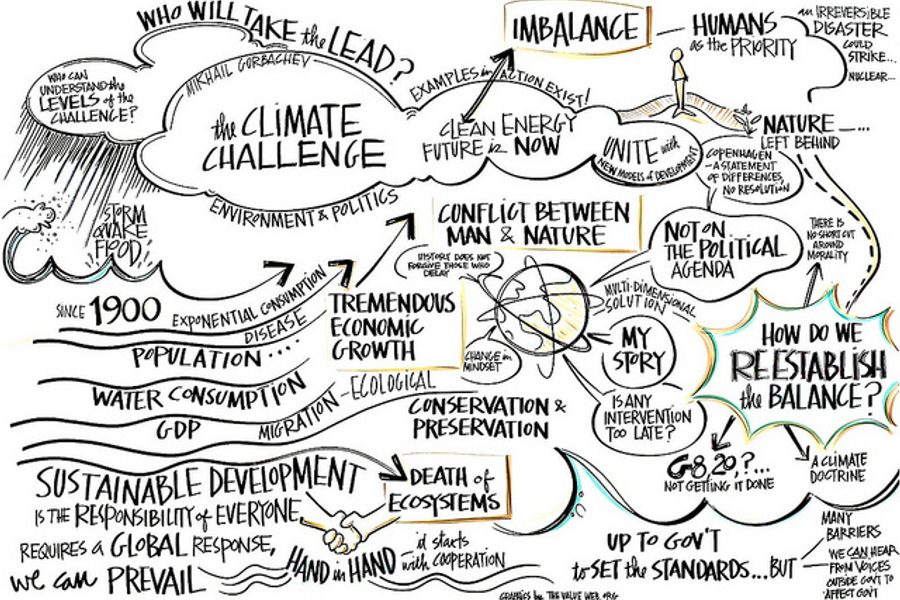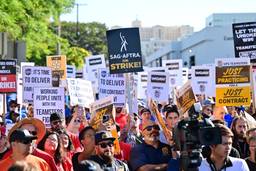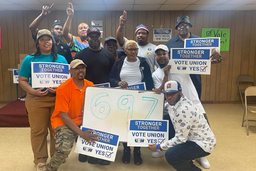
Since the birth of the mainstream environmental movement more than four decades ago, industry interests have promoted an “environment versus jobs” dichotomy wherein environmental protection and regulations theoretically curb economic activity and destroy jobs. Labor unions have often opposed environmental regulation for these reasons, but since “Teamsters and Turtles” joined together at the protests against the World Trade Organization in Seattle in 1999, unions have increasingly joined forces with environmentalists.
This evolution took certain stage following President Barack Obama’s description of his proposed Climate Action Plan at Georgetown University on Tuesday.
“Since the EPA was created and the Clean Air Act was passed, there’s a very strong record showing how in case after case — whether it’s the removal of CFCs or taking lead out of fuels — these dire predictions about job loss and economic calamity proved to be false,” BlueGreen Alliance executive director David Foster told In These Times. The BlueGreen Alliance brings together many of the country’s largest unions with environmental groups such as the Natural Resources Defense Council and Sierra Club. Foster said environmental regulations create “solutions that drive the economy forward.”
Meanwhile Republicans were quick to call the climate plan a “war on jobs,” intertwined with what they have long charged is the administration’s “war on coal.” Fox Nation’s headline: “Obama Climate Plan: Kill jobs, coal, growth.”
House Speaker John Boehner accused the administration in a Tweet of a “war” on American energy And Rep. Joe Barton (R-Texas) tweeted that, “POTUS’ #WarOnCoal policies put U.S. #manufacturing renaissance at risk #NationOfBuilders #4jobs.”
“The restrictions are economically punishing because they will drive up energy prices throughout the U.S. economy, which will stifle job creation and additionally drive existing businesses and jobs overseas,” opined James Taylor, senior fellow for environment policy at the conservative Heartland Institute.
Foster told In These Times that the shift to a new energy economy is inevitable, making it crucial to bring it about in a way that creates quality, U.S. jobs, including ones available to people who will likely lose work in power plants, coal mines and the like.
“This will be a multi-decade process, to say we shouldn’t do it is like saying we should have kept riding horseback when the internal combustion engine was invented,” he said. “There’s no reason that choosing to move to the clean energy economy means people should lose their livelihoods. We need to do it in a mindful way where no one is left behind.”
Chicagoan Jerry Mead-Lucero is both a labor and environmental activist. He hosts a radio show on Labor Express, and leads labor history tours of the city. He is also a member of the Pilsen Environmental Rights and Reform Organization (PERRO), which played a key role in the campaign to shut down two old coal plants of the type that would face new regulations under Obama’s plan.
Mead-Lucero said he was “excited” to hear Obama’s plan, but he is skeptical about how much of it will actually be implemented, especially given the strident political opposition from energy companies, Republican leaders and right-wing grassroots groups. While opponents cry that the plan will destroy jobs, Mead-Lucero fears that Obama’s “timidity” and “strategy of trying to make everyone happy” will ultimately mean the job creation potential of the plan will be squandered.
“The Koch brothers and energy companies have created all this fear, but it’s only a threat to their profits, it’s not a threat to jobs,” Mead-Lucero said. “This could be the Green New Deal. This country is so ripe for massive investments in infrastructure and new energy technologies. We should be doing FDR times five. But that is so far away from what the Obama administration is really going to do.”
Obama’s plan calls for fixing pipeline infrastructure nationwide, in part to reduce leaks of methane, a greenhouse gas much more potent than carbon dioxide. William P. Hite, general president of the United Association of Plumbers and Pipefitters, was especially pleased with this idea. “This is a fixable problem, and accelerating the timeline to repair this system in seven years would create a half million jobs,” he said in the statement from the BlueGreen Alliance, which also included glowing endorsements of the plan from leaders of the American Federation of Teachers, the Communications Workers of America, the Amalgamated Transit Union, the United Steelworkers, the United Auto Workers, Service Employees International Union and the Utility Workers Union of America.
Theoretically, scores of new jobs should be created by the clean energy components of the plan, which aims to double clean energy generation by 2020 through faster permitting, particularly for major projects on public land; investment in clean energy technology like advanced biofuels; and promoting energy efficiency and stronger fuel economy standards.
Obama’s plan also promises the federal government will help local and state governments improve roads, bridges and shoreline preservation to help deal with the increasing storms and rising sea levels that are expected with climate change. Such efforts will likely be crucial to help residents handle the effects of climate change, and also should create jobs. Likewise jobs should be created and protected if Obama realizes his promise of protecting farmers, ranchers and foresters from the most extreme impacts of climate change, in part through research targeted at their needs.
The plan also includes support for “advanced fossil” energy and nuclear power, sectors that many environmentalists oppose. Mead-Lucero is not happy with such provisions of the climate plan, and thinks regulations on coal plants should be even stricter.
“Coal plants are ultimately going to die,” he said. “Keeping them on the respirator is not the way to keep jobs. We have an opportunity to create real sustainable living wage jobs. We have to take it.”
The climate plan proposes imposing new restrictions on the nation’s fleet of existing coal-fired power plants, many of them archaic and heavily polluting. The plan also aims to curb U.S. coal exports for power plants abroad, a hot topic especially regarding the push to build coal export terminals in Oregon and Washington to ship Powder River Basin coal to China. The companies pushing the plan have framed it as a job-creating enterprise and some unions have backed it — envisioning new jobs and economic stimulus from the greatly expanded rail traffic and port facilities. Critics say only large companies and Chinese producers really stand to benefit.
As with the coal exports debate, tension between labor and environmental interests does still exist, and it has been manifested particularly around the proposed Keystone XL pipeline that would carry Albertan tar sands to Gulf Coast refineries.
Obama’s climate address did not give a clear answer on the pipeline’s fate. Obama said the pipeline would be allowed only if it “does not significantly exacerbate the climate problem.” But it appears he may delay a decision on permitting the Canada to Nebraska segment until winter or beyond.
In the southern United States, where there is often much hostility toward unions, government regulation and environmentalism in general, the Southern Alliance for Clean Energy notes that there is strong support for action on climate.
“Though the South often lags behind other regions in accepting changes to its energy mix, there is real demand for progress in this area where clean energy solutions and carbon emission limitations are most needed,” a statement from the group said, noting that coal-fired power plants in the southeast contribute a disproportionate amount of carbon emissions. The alliance notes that the South can actually be a leader in generating clean energy and creating clean energy-related jobs, since it is home to various military bases, Department of Energy facilities and massive Tennessee Valley Authority power projects, which could all play key roles in a new energy landscape.
The Labor Network for Sustainability website details labor viewpoints about climate change over the past few years, including the controversial ongoing EPA effort to regulate emissions from new coal-fired power plants. It notes that: “Over the past few years, organized labor has increasingly come to terms with the reality of climate change and the necessity of climate protection.”
The Labor Network for Sustainability’s 2012 Jobs Beyond Coal is a manual for helping environmentalists and others involved with the clean power transition to understand the positions and fears of workers. The network launched the Green Workers Alliance to bring the voice of labor into the climate change debate. The alliance web page notes:
“Climate change is already impacting many of our working lives. Some of us work in industries where the impact is negative: as firefighters fighting hotter and more frequent wildfires and New England oystermen facing shellfish extinction within the next 40 years due to rising carbon levels. Others of us work in industries that will gain jobs from efforts to protect the climate: as electrical workers installing solar panels, steelworkers assembling wind turbines and as government workers being redeployed as environmental accountants. Still others of us work in industries that will be transformed by climate protection policies, such as coal mining and forestry, who need and want to be part of the green workforce of the future.”
Kari Lydersen is a Chicago-based journalist, author and assistant professor at Northwestern University, where she leads the investigative specialization at the Medill School of Journalism, Media, Integrated Marketing Communications. Her books include Mayor 1%: Rahm Emanuel and the Rise of Chicago’s 99%.








